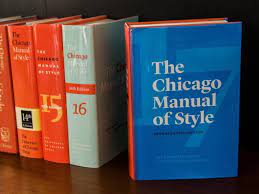Anyone who has used Chicago Manual of Style, or any style guide for that matter, will know that sometimes the rules seem arbitrary or contradictory and full of exceptions. Here are three often confused rules and their many exceptions.
- Number rules: When to use numerals versus when to spell out a number.
- Possessives: Plural possessives and names ending in s
- Punctuation: In and around quotation marks.
The Chicago Manual of Style has an entire section dedicated to the treatment of numbers! Twenty-eight pages of rules in the 17th edition hardcover. One of which I just used in the last sentence, CMOS 9.5: “When a number begins a sentence, it is always spelled out.”
Chicago’s number rules follow a standard pattern for most usages. Numbers one through one hundred are always spelled out (unless used as part of a percentage, date, or time), and those higher than one hundred, and up through the hundred thousands, find whole numbers spelled out—forty-seven thousand or three hundred—with everything else up to one hundred in numeral form—423, 11,354, etc.
But the ultimate exception to the rule comes in Chicago 9.7: Consistency and flexibility.
Where many numbers occur within a paragraph or series of paragraphs, maintain consistency in the immediate context. If according to a given rule you must use numerals for one of the numbers in a given category, use them for all in that category.
Chicago has very specific rules about when to use numerals and when to spell out numbers, here Chicago tells you to forget what you have been taught in the previous seven sections, but to default to the lowest common denominator, aka, if you must use numerals for one, use them for all. Consistency is key.
Possessives are a constant source of confusion for writers and editors alike. Take what is a common area for errors and add in the extra confusion of plural possessives as well as proper nouns ending in s, and you have a formula for exceptions and non-uniform treatment across style guides. The Chicago Manual of Style treats these s-fraught instances in a few different ways.
First, your typical plural noun ending in s receives a solo apostrophe, sans the added s, while a singular noun ending in s—think bass—gets the apostrophe and added s, like any other noun would (CMOS 7.16).
Next, solo proper nouns ending in s get the standard apostrophe +
BUT, when the singular and plural forms of the noun are the same—think species—both forms only receive a solo apostrophe to form the possessive. The Chicago Manual of Style also recommends recasting a sentence to avoid the possessive if confusion is likely. This rule also applies to singular entities that are plural, such as the United States (CMOS 7.20).
To round out our list we have some wonky rules around punctuation, specifically how punctuation functions in and adjacent to quotation marks and parenthesis. First, what you will find is that different punctuation marks have different rules. You would think that commas and semicolons would be treated in a similar fashion. Not so!
Periods and commas are included inside of quotation marks, unless you are British or identifying a file name using quotation marks at the end of a sentence. For example:
He described what he heard as a “short, sharp shock.” (CMOS 6.9)
Vs.
If your server uses “index.html” as its default file name, the name of your own default file cannot be “index.htm”. (CMOS 7.79)
Semicolons, as promised, are treated differently than commas and periods and are placed outside of quotation marks, as are colons. And finally, question marks and exclamation points follow quotation marks, unless they are part of the quote itself (CMOS 6.10).

Indeed, these rules are so often confused that Chicago has a table devoted to explaining where punctuation lands with regard to quotation marks and parenthesis.
So next time you encounter one of these instances while writing or editing, don’t worry. The answers you seek exist complete with their many exceptions.

